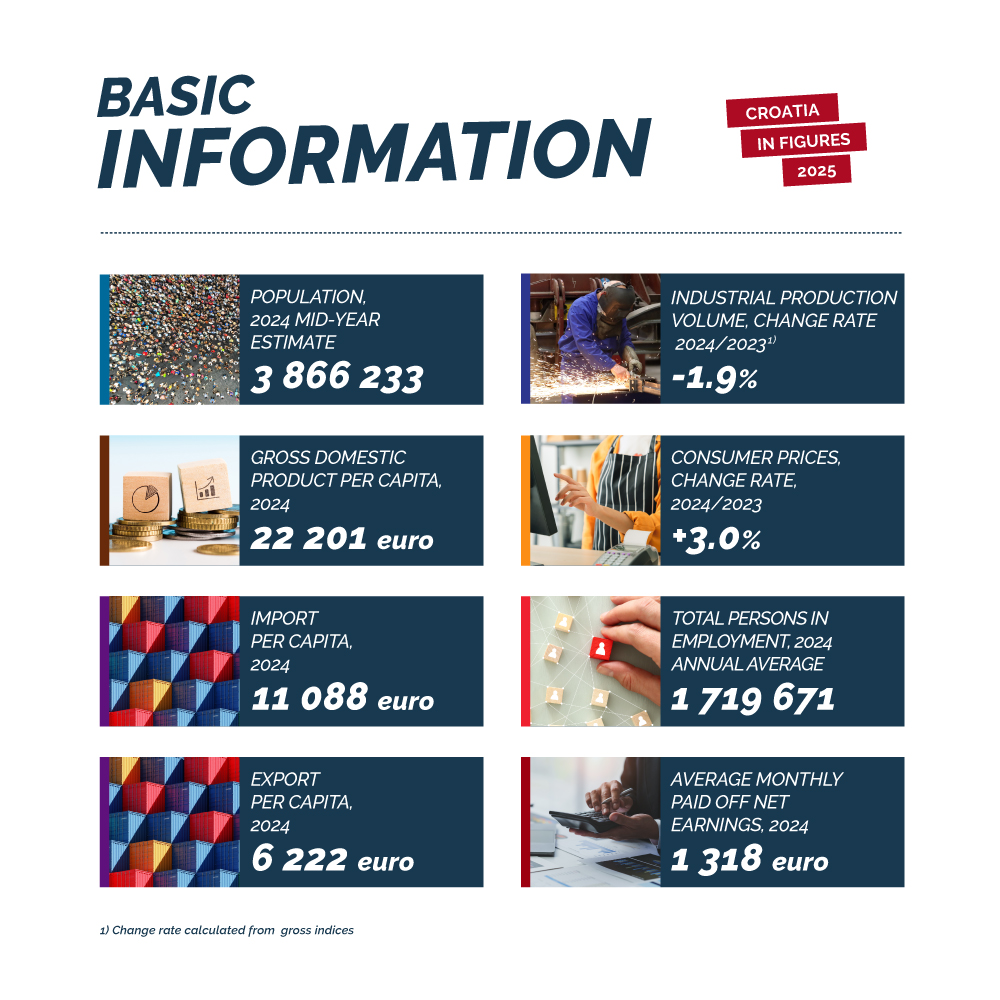| * |
corrected data |
| - |
no occurrence |
| ... |
data not available |
| . |
not zero, but not published due to the extremely inaccurate estimation |
| p |
less accurate estimation |
| ( ) |
less accurate data |
| bn |
billion |
| CEFTA |
Central European Free Trade Agreement |
| CHP |
combined heat and power generation |
| COVID-19 |
COrona VIrus Disease -19 |
| DWT |
deadweight tonne |
| ECOICOP |
Classification of Individual Consumption according to Purpose |
| EU |
European Union |
| EUR |
euro |
| GDP |
gross domestic product |
| GT |
gross tonnage (gross registered tonnage) |
| GWh |
gigawatt hour |
| ha |
hectare |
| kg |
kilogram |
| km |
kilometre |
| km2 |
square kilometre |
| kW |
kilowatt |
m2 |
square metre |
| m3 |
cubic metre |
| MIGs 2009 |
Main Industrial Groupings 2009 |
| mln |
million |
| NIP |
Nomenclature of Industrial Products |
| NKD 2007 |
National Classification of Activities, 2007 version |
| NN |
Narodne novine, official gazette of the Republic of Croatia |
| NPISH |
non-profit institutions serving households |
| t |
tonne |
| '000 |
thousand |
| VAT |
value added tax |
Published by the Croatian Bureau of Statistics, Zagreb, Ilica 3, P. O. B. 80
Phone: (+385 1) 48 06 111
Web site: dzs.gov.hr
Press corner: press@dzs.hr
Persons responsible:
Andrea Galić Nagyszombaty, Director of Statistical Methodologies, Quality and Customer Relations Directorate
Mario Vlajčević, Director of Demographic and Social Statistics Directorate
Suzana Šamec, Director of Macroeconomic Statistics Directorate
Edita Omerzo, Director of Spatial Statistics Directorate
Milenka Primorac Čačić, Director of Business Statistics Directorate
Lidija Brković, Director General
Prepared by: Kristijan Jurić, Maja Marković, Ana Samaržija and Krunoslav Stažić
Editor: Ljiljana Ostroški
Technical Editor: Ankica Bajzek Cesar
Language Editor: Maja Gregorić
Translator: Neda Batinić
Graphic Design: Sanja Huseinagić and Nino Mrša
ISSN 3044-1692
USERS ARE KINDLY REQUESTED TO STATE THE SOURCE WHEN USING THE DATA
Implementing educational policies and distributing financial resources based on real needs could not be done in a high-quality manner without access to statistical data from the field of education. Changes in, for example, the number of enrolled pupils and students can most certainly be an indicator of demographic trends such as the aging of the population or more intensive migration. In addition, these data are also important for the labour market because they contribute to the assessment of needs and provide valuable information that should be used to adjust educational programs to the actual situation in the labour market.
If we observe a five-year period, the number of pupils who completed basic school increased, except at the end of the school year 2020/2021, when a slight decrease was recorded. The share of female pupils in the total number of pupils who completed basic school slightly increased, from 48.9% at the end of the school year 2022/2023 to 49.2% at the end of the school year 2023/2024.
The number of male and female students who graduated from upper secondary school had been increasing in the previous two years, while in 2024 it slightly decreased. The share of female students in the total number of students who graduated from upper secondary school in 2024 slightly declined again.

In 2024, 9 033 students completed professional studies, while 22 204 completed university studies. The share of female students in university study was higher compared to their share in professional study and it amounted to 64.2%.

In 2024, 609 university specialists obtained their academic titles. Out of those 609, 400 were women, who constituted 65.7% of the total number of university specialists. In the same year, 812 doctors of science or doctors of art obtained their academic titles, and women predominated in their total number (60.1%).
In the 2024/2025 academic year, there were 19 594 members of academic staff working at institutions of higher education on an employment contract or a contractual agreement basis. In the academic year 2024/2025, there has been a 5.8% increase in the number of female teachers and teaching associates at institutions of higher education and a 3.7% increase in the number of male teachers and teaching associates compared to the academic year 2023/2024.
← Previous Next →
 Hrvatski
Download data
Hrvatski
Download data



